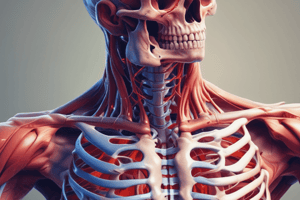Podcast
Questions and Answers
What is the main function of tendons in the skeletal system?
What is the main function of tendons in the skeletal system?
- Connect muscles to bones (correct)
- Connect bones to each other
- Protect internal organs
- Provide human form
Which type of bones are found in the wrist and ankle?
Which type of bones are found in the wrist and ankle?
- Short bones (correct)
- Irregular bones
- Long bones
- Flat bones
What occurs in joints formed by the skeletal system?
What occurs in joints formed by the skeletal system?
- Synovial fluid lubricates movement (correct)
- Bones elongate
- Muscles contract
- Tendons stretch
Which part of the skeletal system is responsible for protecting the brain?
Which part of the skeletal system is responsible for protecting the brain?
What type of bones make up the majority of the appendicular skeleton?
What type of bones make up the majority of the appendicular skeleton?
In what type of injury do strains occur in the skeletal system?
In what type of injury do strains occur in the skeletal system?
Flashcards are hidden until you start studying
Study Notes
- An organ system is composed of at least two types of tissues organized to perform complex tasks.
- The human body has 12 major organ systems, including integumentary, skeletal, muscular, nervous, endocrine, circulatory, lymphatic, immune, respiratory, digestive, urinary, and reproductive systems.
- The skeletal system provides the human form, protects internal organs, and consists of bones, cartilage, tendons, and ligaments.
- Tendons connect muscles to bones, ligaments connect bones to each other.
- Sprains occur when bone ends partially dislocate and ligaments are stretched or torn, strains occur when muscles are stretched or torn.
- Bones are classified as long, short, or flat bones.
- Long bones include femur, tibia, fibula, radius, and humerus; short bones are found in the wrist and ankle; flat bones are in the skull, ribs, sternum.
- Long bones consist of a shaft, ends, and growth plate where bone elongation occurs.
- Joints are formed where two long bones come into contact; held together by a joint capsule and synovial fluid lubricates them.
- The skeletal system is divided into the axial skeleton (skull, thoracic cage, vertebral column) and appendicular skeleton (arms, legs, pelvis).
- The skull contains 28 bones in auditory ossicles, cranium, and face; cranial vault protects the brain.
- The spinal column supports the body and protects the spinal cord; divided into cervical, thoracic, lumbar, sacrum, coccyx sections.
- The thorax includes 12 thoracic vertebrae, 12 pairs of ribs, protects internal organs like the heart and lungs.
- The appendicular skeleton includes bones of shoulder and pelvic girdles, upper and lower extremities.
- Muscles in the musculoskeletal system enable body movement with over 600 voluntary muscles.
- Muscle contraction requires ATP for energy; ATP breakdown uses CRE phosphate to convert ADP back into ATP.
- Oxygen debt occurs when muscles require oxygen to convert lactic acid to glucose and restore ATP levels.
Studying That Suits You
Use AI to generate personalized quizzes and flashcards to suit your learning preferences.




